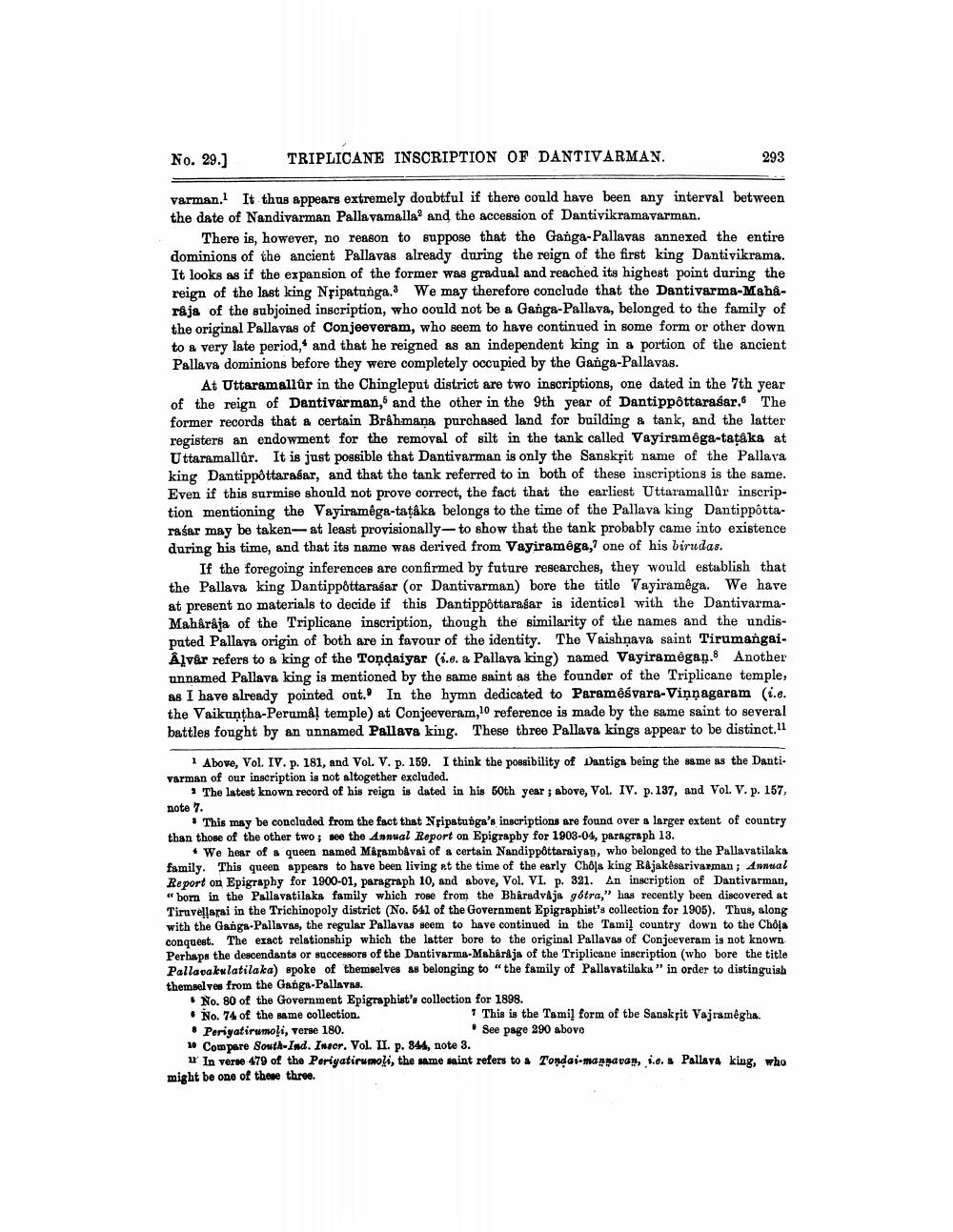________________
No. 29.]
TRIPLICANE INSCRIPTION OF DANTIVARMAN.
varman. It thus appears extremely doubtful if there could have been any interval between the date of Nandivarman Pallavamalla and the accession of Dantivikramavarman.
There is, however, no reason to suppose that the Ganga-Pallavas annexed the entire dominions of the ancient Pallavas already during the reign of the first king Dantivikrama. It looks as if the expansion of the former was gradual and reached its highest point during the reign of the last king Nripatunga.3 We may therefore conclude that the Dantivarma-Maharaja of the subjoined inscription, who could not be a Ganga-Pallava, belonged to the family of the original Pallavas of Conjeeveram, who seem to have continued in some form or other down to a very late period, and that he reigned as an independent king in a portion of the ancient Pallava dominions before they were completely occupied by the Ganga-Pallavas.
293
At Uttaramallûr in the Chingleput district are two inscriptions, one dated in the 7th year of the reign of Dantivarman, and the other in the 9th year of Dantippôttarasar. The former records that a certain Brahmana purchased land for building a tank, and the latter registers an endowment for the removal of silt in the tank called Vayiramêga-taţâka at Uttaramallûr. It is just possible that Dantivarman is only the Sanskrit name of the Pallava king Dantippóttarasar, and that the tank referred to in both of these inscriptions is the same. Even if this surmise should not prove correct, the fact that the earliest Uttaramallûr inscription mentioning the Vayiramêga-tataka belongs to the time of the Pallava king Dantippôttarasar may be taken- at least provisionally-to show that the tank probably came into existence during his time, and that its name was derived from Vayiramêga, one of his birudas.
If the foregoing inferences are confirmed by future researches, they would establish that the Pallava king Dantippôttarasar (or Dantivarman) bore the title Tayiramêga. We have at present no materials to decide if this Dantippôttarasar is identical with the DantivarmaMaharaja of the Triplicane inscription, though the similarity of the names and the undisputed Pallava origin of both are in favour of the identity. The Vaishnava saint TirumangaiAlvar refers to a king of the Tonḍaiyar (i.e. a Pallava king) named Vayiramêgan.8 Another unnamed Pallava king is mentioned by the same saint as the founder of the Triplicane temple, as I have already pointed out. In the hymn dedicated to Paramêsvara-Vinnagaram (i.e. the Vaikuntha-Perumal temple) at Conjeeveram,10 reference is made by the same saint to several battles fought by an unnamed Pallava king. These three Pallava kings appear to be distinct.11
1 Above, Vol. IV. p. 181, and Vol. V. p. 159. I think the possibility of Dantiga being the same as the Dantivarman of our inscription is not altogether excluded.
The latest known record of his reign is dated in his 50th year; above, Vol. IV. p. 137, and Vol. V. p. 157, note 7.
This may be concluded from the fact that Nripatunga's inscriptions are found over a larger extent of country than those of the other two; see the Annual Report on Epigraphy for 1903-04, paragraph 13.
We hear of a queen named Magambâvai of a certain Nandippôttaraiyan, who belonged to the Pallavatilaka family. This queen appears to have been living at the time of the early Chôla king Rajakêsarivarman; Annual Report on Epigraphy for 1900-01, paragraph 10, and above, Vol. VI. p. 321. An inscription of Dantivarman, "born in the Pallavatilaka family which rose from the Bharadvaja gótra," has recently been discovered at Tiruvellarai in the Trichinopoly district (No. 541 of the Government Epigraphist's collection for 1905). Thus, along with the Ganga-Pallavas, the regular Pallavas seem to have continued in the Tamil country down to the Chola conquest. The exact relationship which the latter bore to the original Pallavas of Conjeeveram is not known Perhaps the descendants or successors of the Dantivarma-Maharaja of the Triplicane inscription (who bore the title Pallavakulatilaka) spoke of themselves as belonging to "the family of Pallavatilaka" in order to distinguish themselves from the Ganga-Pallavas.
No. 80 of the Government Epigraphist's collection for 1898. No. 74 of the same collection.
This is the Tamil form of the Sanskrit Vajramêgha. * See page 290 above
Periyatirumoli, verse 180.
10 Compare South-Ind. Insor. Vol. II. p. 344, note 3.
u In verse 479 of the Periyatirumoli, the same saint refers to a Tondai-mannavan, i.e. a Pallava king, who might be one of these three.




